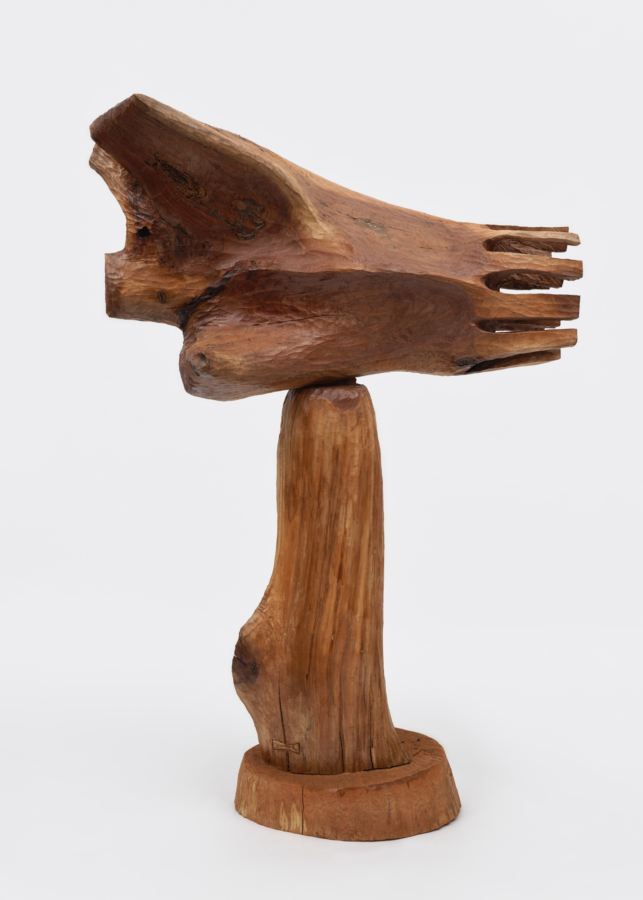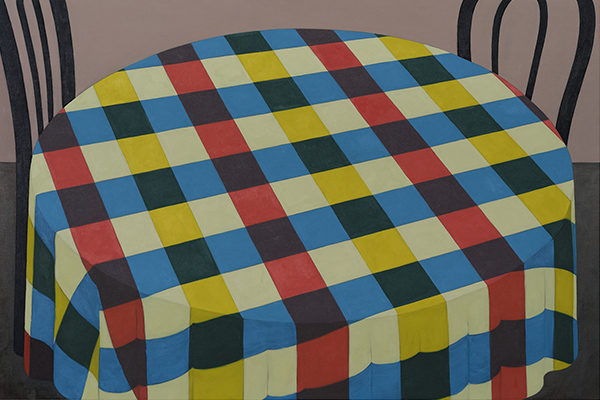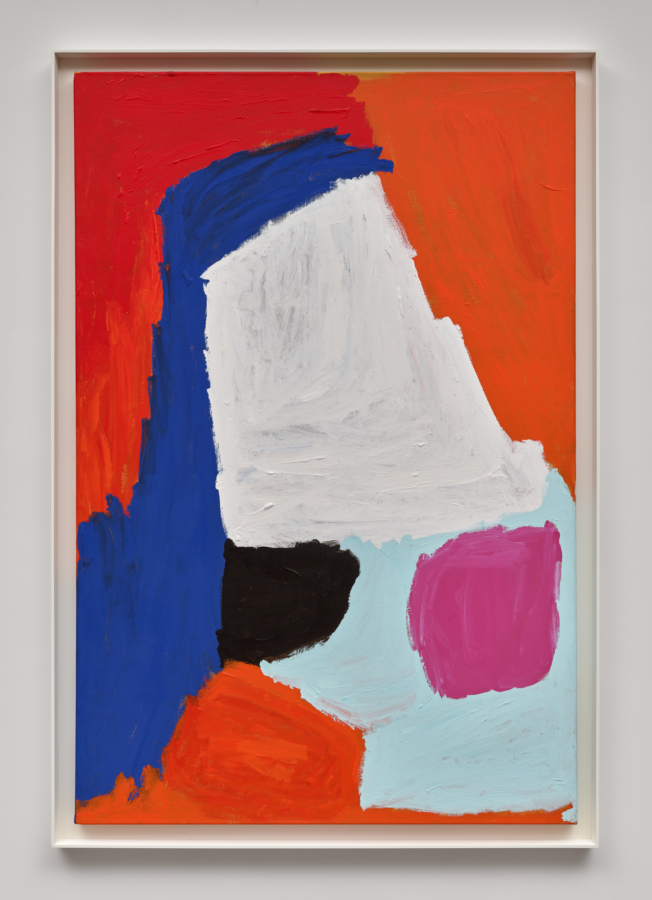2024
Olivia Foundation, Mexico City, 2024
Diana Nawi: I want to start in broad terms. Between Us is not a thesis-driven show, but it does create or allude to the possibility of painterly genealogies. When you and I first met, we touched on the relationship between your work and the paintings around it in the show. I want to continue that conversation. In my experience, some artists are generally attuned to where they are located, or where they are trying to locate themselves, within a Western canon of painting. Others are more insular, making paintings and allowing someone else to place them within that conversation. How do you think about the painting that comes before you, particularly abstraction?
Marley Freeman: To answer your question from the direct perspective of painting, I am constantly locating myself within and against the canon, though I think much more about the studio as a hermetic space than I do about the reception and what happens once the work is in public. While working, I’m constantly thinking of other painters.
Thinking about abstraction, I always refer back to how I started painting—and that was really thinking about image making and looking at what’s around me. I was thinking about advertising, because that’s what I saw in New York. I urgently felt like I wanted to see something different from what I was seeing, and I hated how images always inferred consumption. How do I make something that feels like it’s not for consumption? That line of thinking leads pretty directly to art making. I didn’t know what that was, but painting seemed like the easiest way to make an image that was not in service to capitalism. As a low-wage worker in the design industry, it was really a way of expressing freedom in a very expensive and codifying city. I think you need to be a little upset with culture to become a producer on your own terms.
DN: What were you doing for work at the time?
MF: I organized a design library for an upholstery textile mill. The mill was in Pennsylvania, the library was in Connecticut (at my boss’s house), and our office was in New York. That was my first job in New York. I hadn’t gone to college; I was hired as a junior designer because my father was in textiles. So, they gave me the assignment of organizing the swatch library because it was something I could do without training. The library had five generations of material. It was an incredible task for my twenty-one-year-old brain and really provided a wonderful education in surface and textile design history from the perspective of production. That’s what I was thinking about when I was thinking about making paintings. The repetition in design (consumer) history and my own aversion to what I was seeing in New York.
DN: And when did you ensconce yourself in painting, if you ever did?
MF: Not until later. My boss told me to get out of textiles because the industry was collapsing, so I decided to go back to school, to the School of the Art Institute of Chicago. The Art Institute is an incredible museum, but at the time I didn’t know how to look at a painting. Right after I got to Chicago, I had a spiritual moment with a photograph in the museum and I had an epiphany—“I understand how to look at painting!” It was a photograph of Edward Hopper in his studio, which seems random, but suddenly, I loved painting. I loved his paintings—and I became obsessed with looking at painting. It was something about how radical it was that this is how he spent his days—staring at this easel in a room, contemplating image making. It blew my mind. Then I loved painting.
DN: When did you figure out your mode of painting, what you think of as your way or style of painting?
MF: I started painting classes at the Art Institute around that time, in 2006; you can look at those paintings and they’re not that different from what I’m doing now. There is a lot of continuity in the way I’m using the shape of the brush, using transparency and opacity. I tried lots of things—figure painting classes, etc., but I had an affinity for abstract painting from when I picked up a brush.
DN: I was recently thinking about how and when we learn to look at painting. You alluded to this in your own case and, for me, it’s something that took a long time (well beyond my time at art school). How I was able to understand and articulate abstract painting and how I was looking at the works in the show is in large part through the idea that painting is a set of languages. And not to overextend a metaphor, but is each artist using a different vocabulary? Is it your own language? Where does that come from?
MF: When I saw Helen Frankenthaler’s piece [Untitled, from 1965], I thought, “Whoa, she’s speaking my language.” But obviously, I’m speaking her language. How did that happen? It was surprising. I get annoyed or am not interested when someone is using someone else’s language very directly. Partly why I paint is a response to that. I don’t mind the digestion of other work at all! In a way, that’s what abstraction is—and it has a history of that. But if a work is citing too directly, I get annoyed or disinterested. That’s where I am the most fussy. Like Cecily Brown, when you look at a Cecily Brown painting, it’s Cecily Brown language. Howardena Pindell, that’s Howardena Pindell language. The painters I most admire speak their own language to themselves.
DN: Part of what I was taught is that there’s a kind of painting that is in fact about cribbing language, appropriating the language of other painters or technologies or image forms—it’s a kind of collaging almost.
MF: Yes, cribbing is a big part of painting. Painting is so mercurial—I have to lose it in a way to get it. The only way to work through ideas is to paint through them. And in a mysterious way, different artists will come to mind at different times. It’s part of what makes painting special—one sort of naturally moves through “ideas” while looking at what other painters have done and sometimes that gets digested into one’s own works. I think it works in a way like memory and images, generally. They linger in the imagination and are digested in a way that’s different from text; you absorb them. Most contemporary art does use the idea of collage if you think of collage as a visual idea of appropriating from different sources. Being in a big city like New York, where there is so much art, or just generally looking at the internet, has made me a reference machine. Trying to make something original when I was in school was almost abject. It was as if we were meant to take part in a larger art historical conversation but without our own voice. But in another way, I was probably sensitive to cribbing because of my experience in design where absolutely nothing (or very little) felt original—everything was a copy of a copy. And you can only do that so many times before everything feels compromised or you need to take a risk. It’s a lot easier to take risks as an individual person than as an organization or company, though. So, art is a perfect place to do that. I wasn’t thinking of art or painting as much as I was thinking about looking in a larger sense.
DN: The show at Olivia Foundation creates––or forces––a pretty immediate conversation between works. So, in this instance your work is hanging side by side with the small Frankenthaler that you mentioned, and other artists are placed in relation to peers or predecessors, sometimes in unlikely ways. Is that something you do? Do you contextualize your work or yourself in that way?
MF: As I said, painting, to me, is pretty hermetic, though I’m thinking through other paintings and painters while I’m working. But I am really working against myself primarily. I don’t mind the way the show contextualizes us together because it is obvious when you look at the works together and that is amazing—but it is not anything I expected. She’s not the first artist I would have thought of as simpatico. I don’t think I’ve ever seen her small paintings; I tend to really love small painting and small abstraction. I like more condensed paintings. I really want an intense space, like a space in your head. I have a much harder time relating to or feeling bigger paintings.
DN: So, if a small painting has a relationship to your headspace, how do you think about large paintings?
MF: It’s about body size. It’s a very personal thing—I think large things intimidate me. Looking at painting is such an intimate experience. I only feel comfortable if something is not trying to overpower me. I can conceptually understand why large paintings are impressive, but I don’t generally like looking at them. So, I probably didn’t give Frankenthaler the time she deserved because the scale I have seen of her works intimidated and isolated me.
Generally, I’m pretty nonhierarchical . . . maybe that comes from textiles. I don’t think, “This is so important; that’s not so important.” It’s more like, “Oh, I love that painting. Oh, I love that painting. Oh, I don’t like that painting.” So, I don’t think I saw the show and had any kind of revelation about my own place in the reality of capital P painting. Because this show is primarily abstraction, I wander around in an open way—I can see all the works in their own languages and in dialogue. Then I go outside and see people on the street, cyclists, cars, trees, whatever it is; it’s the same kind of wandering.



